To measure fragrance oils accurately for homemade perfumes, you'll need a digital scale with 0.01g precision, clean pipettes, and sanitized bottles. Aim for a 20:80 ratio between fragrance and carrier oils, maintaining a 20% concentration. Don't rely on drop counting alone, as sizes vary between droppers. Record your measurements precisely in a spreadsheet and follow IFRA safety guidelines. Understanding the nuances of proper measurement techniques will transform your perfume-making journey.
Essential Tools and Equipment for Accurate Measurements
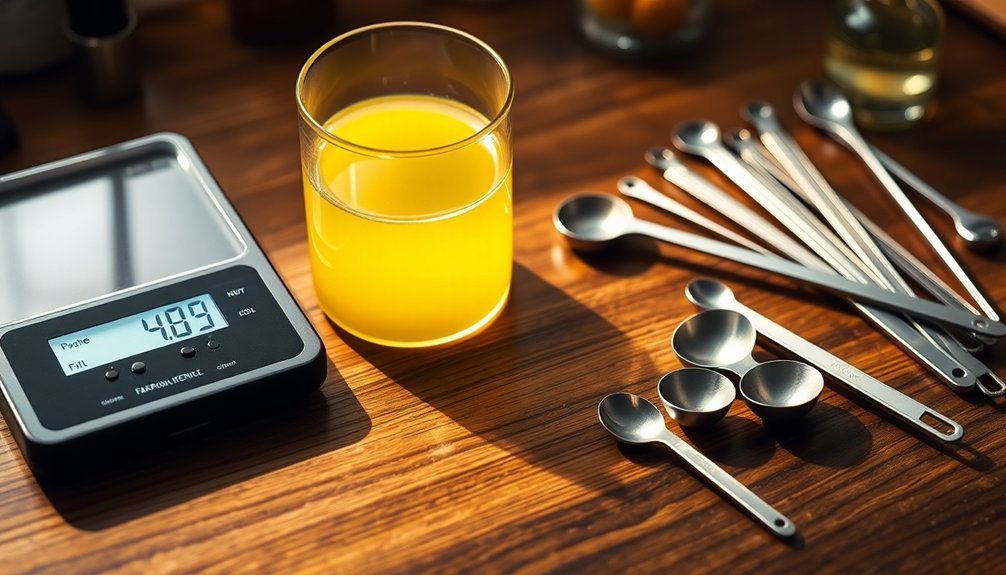
Precision is paramount when measuring fragrance oils, and you'll need the right tools to achieve consistent results. A digital scale with 0.01g precision should be your primary measuring tool, as it provides the accuracy needed for perfect formulations.
You'll want to equip your workspace with graduated pipettes or droppers for handling small volumes, while keeping graduated cylinders or measuring cups handy for larger quantities.
Make sure you're working on a clean, protected surface with sanitized bottles and droppers to prevent any cross-contamination of your oils.
Don't forget to maintain a detailed record of your measurements. Whether you prefer a notebook or spreadsheet, tracking your formulations will help you replicate successful blends and make precise adjustments to future batches.
Understanding Fragrance Oil Concentrations
Getting your fragrance oil concentrations right can make or break your perfume creation. When working with fragrance oils, you'll want to aim for a concentration between 10% to 30%, depending on how strong you'd like your scent to be.
Mastering fragrance concentrations is essential – aim for 10-30% oils to create the perfect perfume intensity for your signature scent.
For best results, use a precise scale that measures down to 0.01g instead of relying on drop counting.
For a standard 5ml perfume, here's a proven formula breakdown:
- Base notes: 10 drops (50% of fragrance oils)
- Heart notes: 5 drops (25% of fragrance oils)
- Head notes: 5 drops (25% of fragrance oils)
- Carrier oil: 80% of total volume
Remember to maintain a 20:80 ratio between fragrance oils and carrier oil for a balanced 20% concentration.
This guarantees your perfume has the right strength while maintaining proper scent development.
The Importance of Weight vs. Volume Measurements
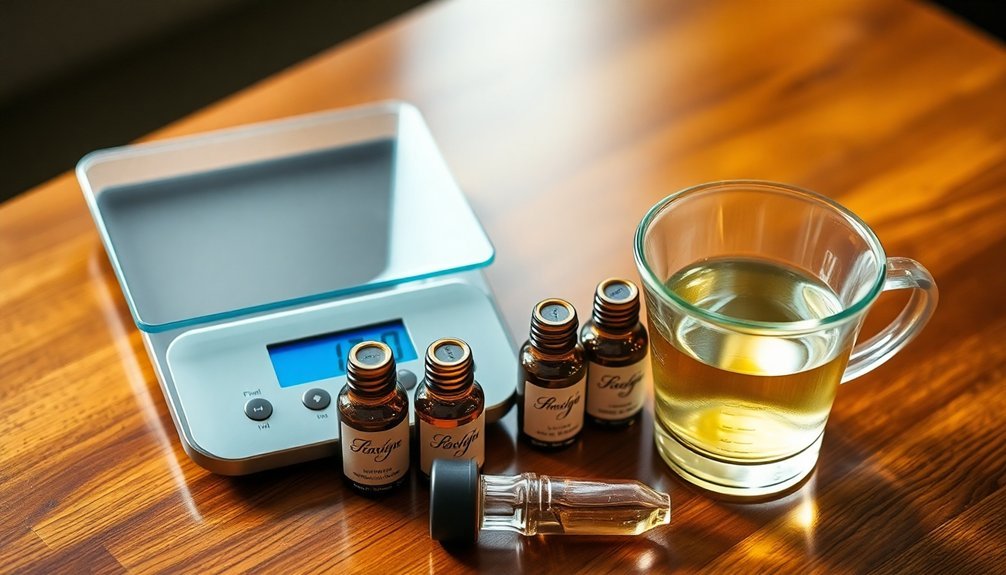
While volume measurements might seem convenient when working with fragrance oils, weight measurements provide far superior accuracy for your perfume formulations.
You'll find that weight-to-volume ratios can vary considerably between different oils, making volume measurements unreliable for consistent results.
To guarantee precision in your fragrance creation, you'll need a scale that measures down to 0.01g.
This level of accuracy helps you maintain consistent concentrations across different batches and eliminates the inconsistencies that come from using droppers or measuring by volume.
When you measure by weight, you'll also find it easier to calculate percentages for your formulations, ensuring that each batch meets your exact specifications.
This method removes the guesswork often associated with varying drop sizes and different interpretations of safe usage limits.
Safety Guidelines and Maximum Usage Rates
When working with fragrance oils, understanding and following safety guidelines becomes vital to protect both yourself and your end users.
You'll need to carefully check IFRA guidelines and safety resources like Good Scents to guarantee your formulations stay within recommended limits.
To maintain proper safety standards in your fragrance work:
- Always weigh ingredients using a precise scale (0.01g accuracy) rather than counting drops.
- Calculate your total formulation percentage to equal exactly 100%.
- Verify IFRA maximum usage rates for each fragrance material before use.
- Perform compliance checks after completing your formulation.
Remember that safety guidelines aren't just recommendations – they're essential safeguards that protect against adverse reactions and guarantee regulatory compliance.
Safety guidelines serve as vital protection mechanisms, not optional suggestions – they safeguard users and ensure products meet critical regulatory standards.
Even small deviations in measurements can impact the safety of your final product, so precision and attention to detail are critical.
Calculating Proper Dilution Ratios

To create a properly diluted perfume oil, you'll need to measure your fragrance oils with precision, preferably using a scale that reads to 0.01g rather than relying on drop counts.
When working with a 20% concentration in a 5ml bottle, combine 20 drops of fragrance oils (10 drops base, 5 drops heart, 5 drops head notes) with 80 drops of carrier oil, always checking IFRA safety guidelines for maximum usage rates.
For consistent results, consider working in units of 100 or 10 – for example, in a 100g batch at 20% concentration, you'd use 20g fragrance oils and 80g carrier oil.
Safety Limits For Oils
Safe dilution ratios serve as the foundation for creating skin-friendly fragrances.
When working with fragrance oils, you'll need to understand safety limits for oils to protect your skin and guarantee compliance with IFRA guidelines.
Using precise measurements with a 0.01g scale, rather than drops, will help you maintain consistent and safe formulations.
For a standard 5ml perfume oil blend, follow these essential safety parameters:
- Keep fragrance concentrates at 20% of total volume
- Use 80% carrier oil as your base
- Verify all components total exactly 100%
- Check IFRA and Good Scents resources for maximum usage rates
Always document your measurements and double-check your calculations before applying any fragrance to skin.
This careful approach guarantees your creations remain both safe and enjoyable.
Weight Vs Drop Measurements
Precision matters greatly when measuring fragrance oils, making weight-based measurements far superior to counting drops. When you're crafting perfumes, you'll want to use a scale with 0.01g precision to guarantee consistent results every time.
While drop measurements might seem convenient, they're unreliable because liquids have different weight-to-volume ratios. For example, in a 5ml perfume bottle with 20% concentration, counting 20 drops of fragrance oil and 80 drops of carrier oil won't give you the accuracy you need.
Instead, using weight measurements helps you maintain exact ratios and stay within IFRA safety limits. To simplify your formulations, calculate percentages by weight, ensuring your total adds up to 100. This method gives you precise control over your fragrance concentrations and creates reproducible results.
Optimal Dilution Reference Tables
Building on the importance of weight-based measurements, let's explore standardized dilution ratios that make perfume creation more manageable.
When determining your fragrance load, you'll want to maintain a 20% concentration for most oil-based perfumes. This means combining 20 parts fragrance with 80 parts carrier oil.
For quick reference, here are common batch calculations using weight measurements:
- 5ml bottle: 1g fragrance + 4g carrier oil
- 10ml bottle: 2g fragrance + 8g carrier oil
- 50ml bottle: 10g fragrance + 40g carrier oil
- 100ml bottle: 20g fragrance + 80g carrier oil
Remember to use a precise scale measuring to 0.01g for accuracy.
You can adjust these ratios based on your desired scent strength, but always maintain clear mathematical proportions to guarantee consistent results.
Scaling Recipes for Different Batch Sizes
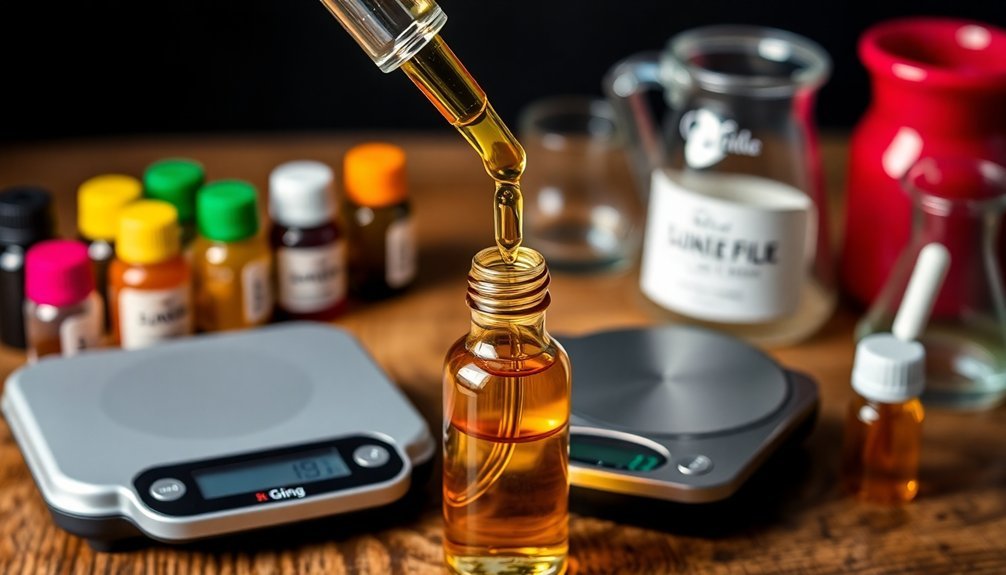
Using percentages is your most reliable method for scaling fragrance recipes, as you'll always maintain proper concentration ratios regardless of batch size.
To convert a small recipe to a larger one, simply multiply your base measurements while keeping the same proportional relationships between ingredients (like maintaining 20% fragrance oil to 80% carrier oil).
You can easily translate a 10g recipe into a 100g batch by multiplying each component by 10 while preserving the original scent profile's integrity.
Percentage-Based Measurement Methods
When working with fragrance oils, percentage-based measurements offer a reliable way to scale your recipes up or down while maintaining consistent scent profiles.
By using percentage-based calculations, you'll guarantee your total formulation always adds up to 100%, giving you precise control over fragrance concentration.
To apply this method effectively:
- Start with your desired batch size (total weight)
- Calculate your fragrance concentration (e.g., 20% of total)
- Determine fragrance oil amount (concentration × total weight)
- Subtract fragrance weight from total to get carrier oil amount
For example, if you're making a 100g batch with 20% fragrance concentration, you'll need 20g of fragrance oils and 80g of carrier oil.
When scaling to a 10g batch, simply use 2g of fragrance and 8g of carrier oil to maintain the same ratio.
Converting Small to Large
The art of scaling fragrance recipes from small test batches to larger production quantities requires precise mathematical calculations and careful attention to detail.
To scale your recipe accurately, you'll need to maintain the same percentage ratios across all components. When working with fragrance oil, switch from drops to weight measurements using a scale with 0.01g precision for better consistency.
If your original formula uses a 20% fragrance concentration in a 100g batch (20g fragrance oil, 80g carrier oil), you can easily calculate new quantities while keeping these proportions.
For example, to double a recipe, simply multiply each component by two while maintaining the original ratios.
Remember to verify safety limits for each ingredient when scaling up, as some materials may have maximum usage restrictions in larger quantities.
Measuring Techniques for Optimal Results
Accurate measurements serve as the foundation for successful fragrance formulation.
You'll need a precise digital scale that measures down to 0.01g to properly weigh your fragrance oils, as this method surpasses counting drops for consistency.
When measuring your ingredients, follow these essential steps:
- Set your scale to measure in grams and calibrate it before each use
- Maintain the 20% fragrance to 80% carrier oil ratio
- Record all measurements in a spreadsheet for future reference
- Consider the weight-to-volume ratios of different oils
For simplified calculations, work with units of 100 or 10.
For example, if you're making 100g of perfume at 20% concentration, you'll use 20g of fragrance oils and 80g of carrier oil.
This systematic approach guarantees repeatable results in your perfume creation process.
Common Measurement Mistakes to Avoid
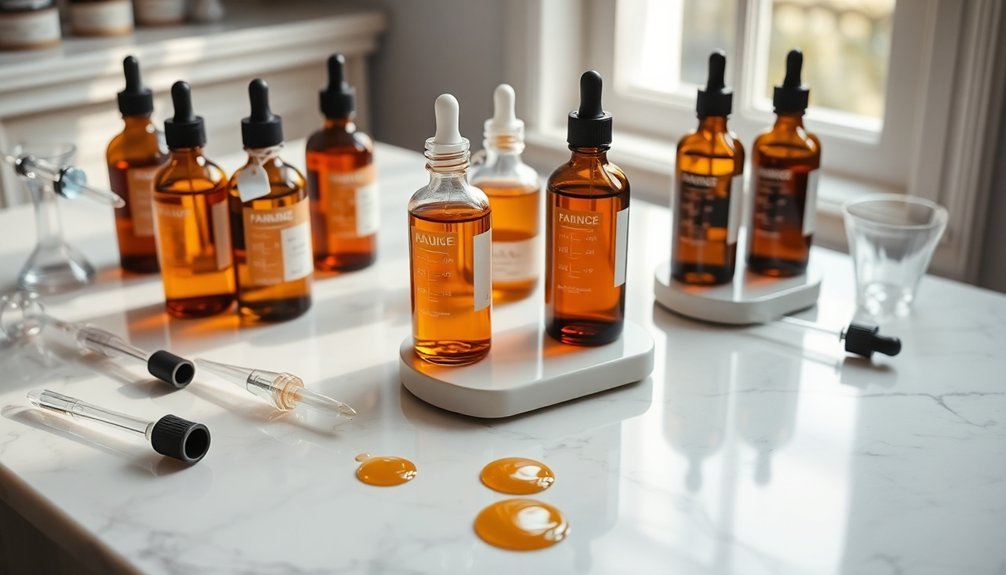
Despite careful attention to measurement techniques, many perfume makers still encounter common pitfalls that can compromise their final product. One major mistake is relying solely on drop counting when measuring fragrance oils, as drop sizes can vary considerably between different droppers and pouring techniques.
Don't make the error of mixing measurements between weight and volume, as this leads to inconsistent results. You'll want to stick to weight-based measurements using a precise scale for accuracy.
Another critical mistake is failing to verify your total formula adds up to 100% when combining carrier oils with fragrance concentrates. Additionally, you might be tempted to exceed IFRA's recommended safety limits for certain materials – don't. This can result in not just an unsatisfactory fragrance but potentially unsafe products.
Always double-check your calculations and maintain consistent measurement methods.
Documenting Your Measurements for Consistency
Maintaining precise records of your fragrance formulations serves as the cornerstone of consistent perfume creation. You'll need to establish a systematic documentation method, whether it's a dedicated journal or digital spreadsheet, to track every aspect of your perfume-making process.
Systematic documentation is essential for perfume making, enabling you to track and replicate your fragrance formulations with precision and consistency.
When documenting your measurements, be sure to:
- Record exact quantities to 0.01g or individual drops for each oil used
- Note the date, specific ingredients, and their ratios
- Track any modifications made during formulation
- Document your observations about the final fragrance
Use a reliable scale for precise measurements and consistently update your records with each batch you create.
This detailed approach helps you replicate successful formulas and learn from less successful attempts, ultimately refining your perfume-making skills through careful analysis of your documented experiences.
Storage and Shelf Life Based on Concentrations
Your fragrance oils' shelf life directly depends on how you store them and their concentration levels, with higher concentrations typically lasting 3-5 years under ideal conditions.
You'll get the most longevity by keeping your oils in dark glass bottles away from sunlight and heat, as improper storage can greatly reduce their lifespan regardless of concentration.
The right container choice is essential – amber or cobalt glass bottles with airtight seals will protect your oils from oxidation and contamination, helping maintain their potency throughout their expected shelf life.
Storage Environment Affects Longevity
When it comes to protecting your fragrance oils, proper storage conditions play an important role in determining how long they'll last. The environment where you keep your homemade perfumes directly impacts their longevity and quality over time.
To maximize the shelf life of your fragrance oils, follow these essential storage practices:
- Store perfumes in dark glass bottles to protect against light degradation.
- Keep bottles in a cool, dry place away from direct sunlight.
- Monitor temperature fluctuations, as heat accelerates fragrance breakdown.
- Check your perfumes regularly for changes in scent or appearance.
Remember that higher concentrations of fragrance oils typically last longer than diluted formulations.
While synthetic fragrance oils generally outlast essential oils due to their chemical stability, both types require proper storage to maintain their integrity and prevent premature degradation through oxidation or evaporation.
Concentration Impacts Expiration Dates
Different fragrance oil concentrations play an essential role in determining how long your perfumes will last.
You'll find that perfumes with lower concentrations, under 10%, typically maintain their quality longer than those with higher concentrations above 20%.
When creating your homemade fragrances, consider using synthetic oils instead of essential oils, as they're more resistant to oxidation and deterioration over time.
To maximize shelf life, incorporate a higher percentage of base notes in your formula.
These notes evaporate more slowly, making your perfume more stable.
Remember to store your creations properly in cool, dark places to protect them from heat and light damage.
Check your perfumes regularly for any changes in scent, color, or clarity – most homemade blends will stay fresh for 6 months to 2 years when properly formulated and stored.
Proper Containers Matter Most
Glass containers serve as the foundation for proper fragrance storage, with amber and cobalt blue bottles offering superior protection against UV damage.
You'll want to choose non-reactive glass containers that can be sealed tightly to prevent oxidation and maintain your perfume's integrity.
To maximize your fragrance's shelf life, follow these essential storage practices:
- Store bottles in a cool, dark place away from direct sunlight
- Keep containers tightly sealed when not in use
- Check regularly for changes in color or consistency
- Choose container size based on fragrance concentration
Remember that higher concentration perfumes typically last longer in storage, while diluted versions may need to be used more quickly.
Frequently Asked Questions
How Do You Measure Fragrance Oil for Perfume?
You'll need a precise scale measuring to 0.01g for accuracy. Don't rely on drops alone. Mix your fragrance oils at 20% concentration, let them rest for a week, then blend with carrier oil.
How Much Fragrance Oil to Make Perfume?
You'll need 20% fragrance oils in your perfume mixture. For a 5ml bottle, use 20 drops total: 10 drops of base notes, 5 drops of heart notes, and 5 drops of head notes.
What Is the 30/50/20 Rule for Perfume?
You'll want to blend your perfume using 30% base notes (like vanilla), 50% heart notes (typically florals), and 20% head notes. This creates a balanced fragrance that unfolds beautifully from first spritz to final dry-down.
What Is the Ratio for Homemade Perfume?
You'll want to use a 20/80 ratio for homemade perfume: 20% fragrance oils (10 drops base notes, 5 drops heart notes, 5 drops head notes) and 80% carrier oil (80 drops total).
In Summary
You'll find measuring fragrance oils becomes second nature with practice and proper tools. Remember to always measure by weight rather than volume, keep detailed records of your formulations, and follow safety guidelines for dilution ratios. Store your properly measured perfumes in dark glass bottles, and you'll create consistent, safe fragrances every time. When in doubt, start with lower concentrations – you can always adjust up.
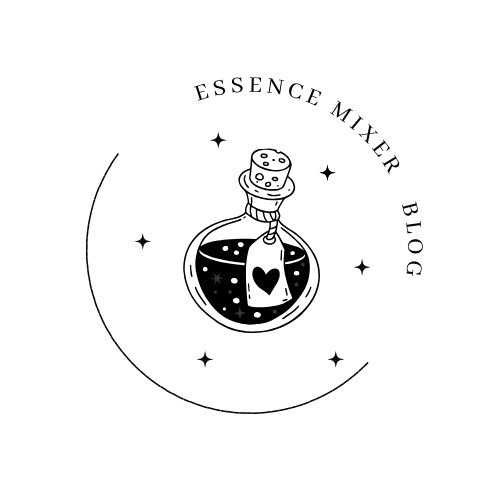
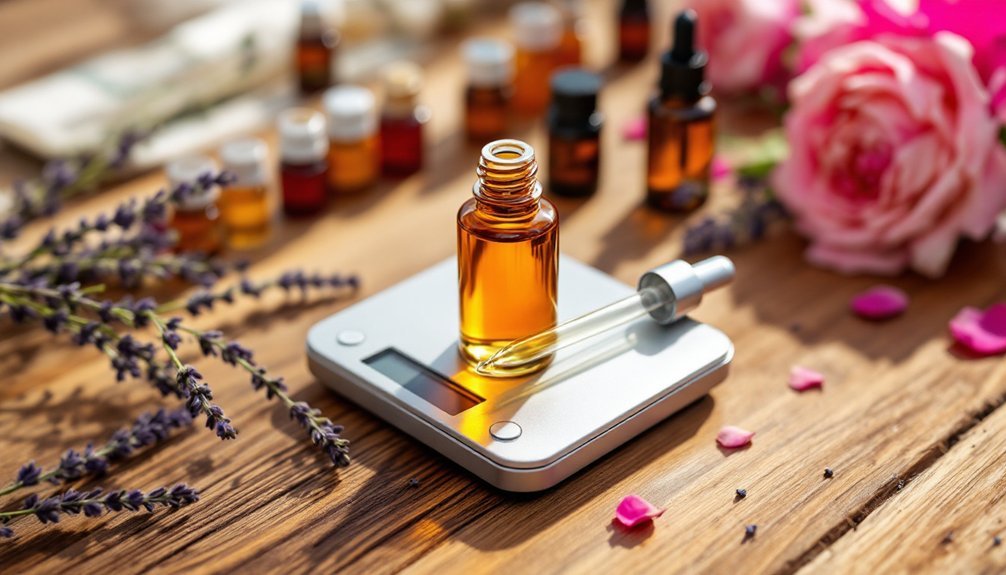



Leave a Reply